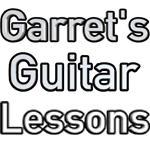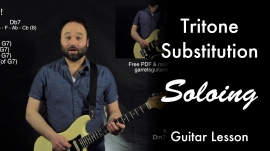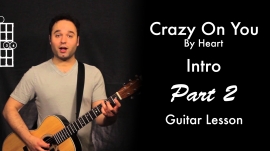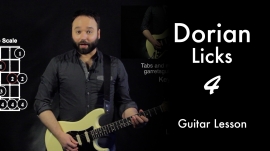The basic concept of this lesson is if we’re playing a Dominant Chord or the Mixolydian Scale we can incorporate a major triad a whole step before it’s root note. The example I use today is A7, so the triad we’re incorporating is a G triad. If we were to be playing D7, the triad would be a C. If we were playing a Bb7, the triad would be an Ab, etc.
I use two main shapes, the E shape and the A alt shape as the basis for our A7 Arpeggio or A Mixolydian scale. My examples are fairly simple as I want you to get familiar with weaving in and out of the Arpeggio/Scale and the Triad. So I start in the Arpeggio/Scale then go into one of the nearest Triad then go back to a note from the Arpeggio/Scale.
Now why a whole step before’s major triad?! If we analyze a G major triad over an A7 we get:
A7: A – C# – E – G
G: G – B – D
The G is the b7 of A7, B would be the 9th, D would the 11th. So we get a ton of upper extensions while just thinking of a simple triad… cool!
Dig.
-Related Lessons-
:18 – “Jenny” | Super Funky Modal Vamp – Mixolydian
:59 – Playing Triads (Whole Neck & All Strings!)
1:07 – 5th String Barre Chords | BO 10/10
1:22 – 6th String Barre Chords | BO 9/10
1:27 – Major CAGED Chord Shapes | CO 1/10
1:35 – Dominant 7 Inversions (Whole Neck!)
1:38 – Mixolydian (Dominant) Scale (Whole Neck!)
2:34 – Extended (7 9 11 13) Chords?! | UGT 3/8
4:11 – Know Not Memorize Your Fretboard | Steps
5:01 – Visualize Chord Tones – E and A Shapes | 7th Chords
PDF’s
Extended Use of Triads | Major Triad Whole Step PDF, Triads, 7th Arpeggio Shapes, Mixolydian Scale Shapes, Dominant 7 Inversions, Open/Barre/Sus Chords, Theory, Basics, CAGED Chord Shapes




